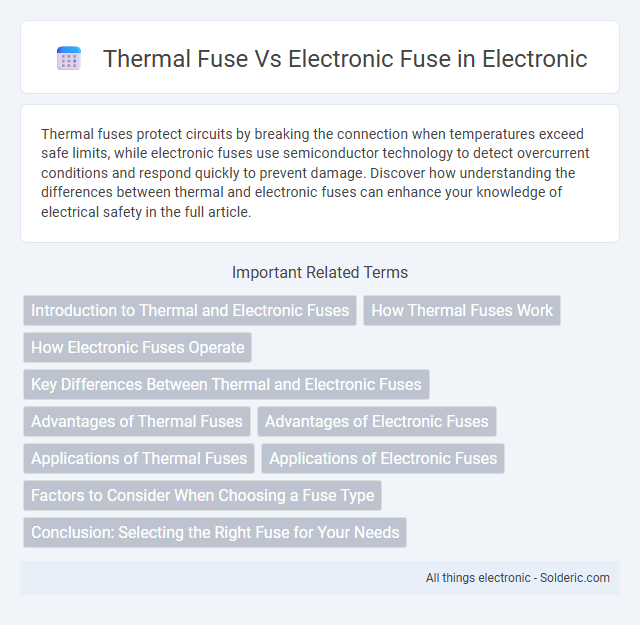Thermal fuses protect circuits by breaking the connection when temperatures exceed safe limits, while electronic fuses use semiconductor technology to detect overcurrent conditions and respond quickly to prevent damage. Discover how understanding the differences between thermal and electronic fuses can enhance your knowledge of electrical safety in the full article.
Comparison Table
| Feature | Thermal Fuse | Electronic Fuse |
|---|---|---|
| Function | Interrupts circuit on overheating | Protects circuit by controlling current electronically |
| Trigger Mechanism | Temperature-sensitive element melts | Electronic sensing and switching |
| Reset Capability | One-time use, must replace after activation | Often resettable or auto-reset |
| Response Time | Slower, depends on heat buildup | Fast, immediate response to fault |
| Applications | Appliances, motors, transformers | Advanced electronics, power supplies, circuit boards |
| Durability | Single-use, limited lifespan | Long-lasting, multiple trips possible |
| Cost | Low cost | Higher cost |
Introduction to Thermal and Electronic Fuses
Thermal fuses are safety devices that interrupt electrical circuits by melting a heat-sensitive alloy when temperatures exceed a specific threshold, preventing overheating and fire hazards. Electronic fuses, also known as solid-state fuses, use semiconductor components to detect overcurrent conditions and disconnect the circuit rapidly without physical damage. Both fuses serve as critical protection mechanisms in electrical systems but differ in response time, reset capability, and application suitability.
How Thermal Fuses Work
Thermal fuses work by using a heat-sensitive element that melts when the temperature exceeds a specific threshold, interrupting the electrical circuit to prevent overheating and potential fire hazards. These fuses are designed to provide one-time protection by physically breaking the circuit once triggered, requiring replacement after activation. Unlike electronic fuses, thermal fuses offer simple, reliable protection based solely on temperature rather than current flow.
How Electronic Fuses Operate
Electronic fuses operate by continuously monitoring electrical current and voltage parameters through semiconductor components, detecting anomalies like overcurrent or short circuits in real-time. When fault conditions are identified, these fuses rapidly interrupt the circuit using solid-state switches such as transistors or thyristors, allowing for precise and reversible protection without physical replacement. This dynamic response minimizes downtime and enhances system reliability in sensitive electronic applications compared to traditional thermal fuses relying on temperature-triggered mechanical disruption.
Key Differences Between Thermal and Electronic Fuses
Thermal fuses rely on temperature-sensitive materials that melt or break the circuit when excessive heat is detected, providing a one-time protection against overheating. Electronic fuses utilize semiconductor components to monitor current flow and can reset automatically after disconnecting during overcurrent situations, offering more precise and reusable protection. Your choice depends on whether you prioritize single-use thermal protection or advanced, resettable electronic safety features.
Advantages of Thermal Fuses
Thermal fuses provide reliable, cost-effective protection by interrupting current flow when temperatures exceed a specific threshold, preventing overheating and potential fire hazards. Their simple design ensures high durability and low maintenance, making them ideal for safety in appliances and electronic devices. Your equipment benefits from the precise thermal cutoff that thermal fuses offer, avoiding damage from excessive heat more effectively than electronic fuses.
Advantages of Electronic Fuses
Electronic fuses offer precise and rapid response to overcurrent conditions, enhancing circuit protection and reducing damage risk to sensitive components. Their ability to reset automatically after faults eliminates the need for replacement, cutting maintenance costs and downtime. Advanced electronic fuse designs also provide better integration with monitoring systems, enabling real-time fault detection and improved overall system safety.
Applications of Thermal Fuses
Thermal fuses are primarily used in household appliances such as coffee makers, hair dryers, and microwave ovens to prevent overheating and potential fire hazards by interrupting the electrical circuit when a specified temperature is exceeded. These fuses are also vital in electric motors and transformers to safeguard against excessive heat buildup during operation. Unlike electronic fuses, thermal fuses provide a reliable, one-time protection mechanism based solely on temperature thresholds rather than current flow, making them essential for thermal safety in consumer electronics and industrial equipment.
Applications of Electronic Fuses
Electronic fuses are widely used in applications requiring precise overcurrent protection, such as in computer motherboards, automotive electronics, and telecommunications equipment. Their fast response times and resettable designs make them ideal for safeguarding sensitive circuits without the need for fuse replacement. You can rely on electronic fuses to ensure continuous operation and enhanced device longevity in technology-driven environments.
Factors to Consider When Choosing a Fuse Type
When selecting between a thermal fuse and an electronic fuse, consider factors such as operating temperature range, response time, and application sensitivity. Thermal fuses provide reliable protection against overheating by physically breaking the circuit at a specific temperature, ideal for appliances with stable thermal conditions. Your choice should account for the precision needed in current interruption, with electronic fuses offering faster reaction times and reset capabilities suited for dynamic electrical environments.
Conclusion: Selecting the Right Fuse for Your Needs
Thermal fuses respond to temperature changes by breaking the circuit when a specified heat level is exceeded, making them ideal for preventing overheating in appliances. Electronic fuses offer faster and more precise protection through current sensing and reset capabilities, suitable for sensitive electronics and complex systems. Choosing the right fuse depends on your device's requirements for speed, sensitivity, and the environment in which it operates.
Thermal Fuse vs Electronic Fuse Infographic

 solderic.com
solderic.com